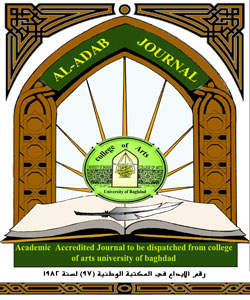A Pragmatic Analysis of Antony’s Oration in Julius Caesar
DOI:
https://doi.org/10.31973/aj.v3i142.3870الكلمات المفتاحية:
Politeness، Speech Acts، Persuasive Communicationالملخص
The present study attempts a pragmatic analysis of Antony’s famous oration in Shakespeare’s Julius Caesar. It aims to identify which speech acts were employed in this oration for the end of achieving a high level of persuasion and, hence, characterizing Antony’s peculiar persuasive style. To achieve this objective, the study adopts a pragmatic analysis utilizing the speech act theory whereby all speech acts uttered by Antony were hand-picked and collated to represent the data of the study. In the analysis of the data, Searle’s (1969) model for categorizing speech acts was adopted to best reflect the speech acts that helped exhibiting the persuasive intent of the writer. Leech’s (1983) politeness principles are adopted to show how polite the characters to each other. The finding of the study shows that the role of speech acts for persuasive goals was vital. It can be concluded that speech acts such as declarations, commissives, directives, etc., were all employed to achieve this rhetorical intention, however, the speech acts of representative were the most significant to portray Antony’s peculiar persuasive style.
التنزيلات
المراجع
Austin J. L. (1962). How to Do Things with Words. Oxford University Press.
Bach, K., & Harnish, R. M. (1979). Communication and Speech Acts. Cambridge, Mass.: Harvard University Press, p. xvi.
Brown, P. & Levinson, S., C. (1997). Politeness. Cambridge: Cambridge University Press.
Clark, H. H. (1979). Responding to Indirect Speech Acts. Cognitive psychology, 11(4), p.430-477.
Ching, M.; Michael H. and Ronald L. (1980). Linguistics on Literature. London: Routledge and Kegar and Paul, p.4.
Cutting, J. (2002). Pragmatics and Discourse. London: Routledge, p.43-44, 49, 50.
Al. A’dhemi, N. (1998) ‘’Indirect Illocutionary Act of Interrogation Structures in Modern English Texts and ELT Textbooks’’.(Unpublished M.A. Thesis), University of Baghdad.
Farch, L. (2002) ‘’Illocutionary Forces of Imperative Sentence; in English and Arabic: A Comparative Study: Unpublished MA Thesis. The University of Jordan, p.45,52, 38.
Leech, G. (1980). Exploration in Semantics and Pragmatics. Amsterdam: John Benjamin Br, p.13.
Leech, G. (1983). Principles of Pragmatics. London: Longman, p. 40, 82, 131, 143, 179.
Mills, S. (2003). Gender and Politeness (Vol. 17). Cambridge University Press, p.137.
Niazi , N. (2004) . Novel and Interpretation: A pragmatic Approach. 1st ed. Forum for cultural studies, p.32.
NÖth, W. (1995). The Handbook of Semiotics. Indiana University Press, p.52.
Ohman, R. (1981). ‘’Speech Acts and the Space between’’ in Freeman Donald (ed) Essays in Modern Stylistic. London. Methneu,p.367.
Pratt, M. (1977). Towards a Speech Act Theory of Literary Discourse. USA. Indian University Press, p.16, 69.
Reiter, R. (2000). Linguistic Politeness in Britain and Uruguay: A Contrastive Study of Requests and Apologies. Amsterdam/ Philadelphia: John Benjamin,p.2, p.47.
Searel, J. (1969). Speech Acts: An Essay in the Philosophy of Language. Cambridge University Press, p.17.
Searle, J. (1975). Indirect speech acts. Syntax and semantics, ed., by Peter Cole and Jerry L. Morgan, 59-82. New York: NY: Academic Press, p.76.
Schauer, G. A. (2009). Interlanguage pragmatic development. London: International Group, p.12.
Searle, J. R., Kiefer, F., & Bierwisch. M. (eds.). (1980). Speech Act Theory and Pragmatics. ISBN 90-277-1043-0. London: D. Reidel Publishing Company, p. vii, viii.
Short, M. (1989). ‘’Discourse Analysis and Drama’’ in Carter Simpson (ed). Language Discourse and Literature. London: Vawin Hyman,p.149.
Thomas, J. (1995). Meaning in Interaction: An Introduction to pragmatics. London: Long man Group Ltd, p.164.
Yule, G.(1996). Pragmatics. Cambridge: Cambridge university Press, p.3,60.
Vanhoozer, K. J. (2002). First Theology: God, Scripture & Hermeneutics. Intervarsity Press, p. 182.
Watts, R., J. (2003). Politeness. Cambridge: Cambridge University Press, p.10.
Abd Al-Aziz, N. (2003, ‘’The Ability of Iraqi CEFU Learners to Recognize and Produce the Illocutinary Force of Imperative Structures’’. (Unpublished M.A. Thesis) University of Baghdad, p.2, 98.
التنزيلات
منشور
إصدار
القسم
الرخصة
:حقوق الطبع والنشر والترخيص
بالنسبة لجميع البحوث المنشورة في مجلة الآداب، يحتفظ الباحثون بحقوق النشر. يتم ترخيص البحوث بموجب ترخيص Creative Commons CC BY 4.0 المفتوح ، مما يعني أنه يجوز لأي شخص تنزيل البحث وقراءته مجانًا. بالإضافة إلى ذلك ، يجوز إعادة استخدام البحث واقتباسه شريطة أن يتم الاستشهاد المصدر المنشور الأصلي. تتيح هذه الشروط الاستخدام الأقصى لعمل الباحث وعرضه.
:إعادة إنتاج البحوث المنشورة من الناشرين الآخرين
من الضروري للغاية أن يحصل الباحثون على إذن لإعادة إنتاج أي بحث منشورة (أشكال أو مخططات أو جداول أو أي مقتطفات من نص) لا يدخل في نطاق الملكية العامة أو لا يملكون حقوق نشرها. يجب أن يطلب الباحثون إذنًا من مؤلف حقوق النشر (عادة ما يكون الناشر).
يطلب الإذن في الحالات التالية:
بحوثك الخاصة المنشورة من قِبل ناشرين آخرين ولم تحتفظ بحقوق النشر الخاصة بها.
مقتطفات كبيرة من بحوث أي شخص أو سلسلة من البحوث المنشورة.
استخدم الجداول والرسوم البيانية والمخططات والمخططات والأعمال الفنية إذا لم يتم التعديل عليها.
الصور الفوتوغرافية التي لا تملك حقوق لنشرها.
لا يطلب الإذن في الحالات التالية:
إعادة بناء الجدول الخاص بك مع البيانات المنشورة بالفعل في مكان آخر. يرجى ملاحظة أنه في هذه الحالة يجب عليك ذكر مصدر البيانات في شكل "بيانات من ..." أو "مقتبس من ...".
تعتبر عروض الأسعار القصيرة معقولة الاستخدام العادل ، وبالتالي لا تتطلب إذنًا.
الرسوم البيانية ، الرسوم البيانية ، المخططات ، الأعمال الفنية التي أعاد الباحث رسمها بالكامل والتي تم تغييرها بشكل ملحوظ إلى درجة لا تتطلب الاعتراف.
الحصول على إذن
لتجنب التأخير غير الضروري في عملية النشر ، يجب أن تبدأ في الحصول على أذونات في أقرب وقت ممكن. لا يمكن لمجلة الآداب نشر بحث مقتبس من منشورات أخرى دون إذن.
قد يمنحك مالك حقوق الطبع والنشر تعليمات بشأن شكل الإقرار الواجب اتباعه لتوثيق عمله ؛ بخلاف ذلك ، اتبع النمط: "مستنسخ بإذن من [المؤلف] ، [كتاب / المجلة] ؛ نشره [الناشر] ، [السنة]." في نهاية شرح الجدول ، الشكل أو المخطط.
.jpg)
























